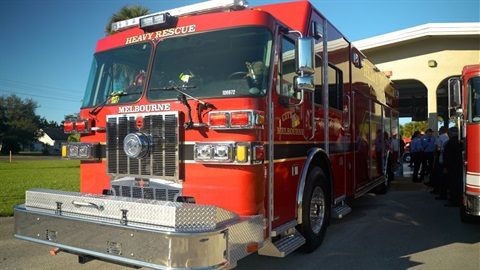Melbourne Fire Department’s First Heavy Rescue Vehicle Begins Service
Published on October 31, 2025

After years of planning, designing, and training, the Melbourne Fire Department has placed its first-ever heavy rescue truck into service. The new heavy rescue truck was dedicated during a traditional “Push In” ceremony on October 31 at Fire Station 76 (located on the corner of Lake Washington Road and Croton Road).
This new specialized apparatus is called a “heavy rescue” because it carries a variety of tools and trained personnel needed to respond to building collapses, accidents involving large vehicles like buses or semi-trucks, and to perform confined space rescues and trench rescues.
Responding to these types of incidents requires both specialized equipment and specialized training called “technical rescue.” Over the past several years the Melbourne Fire Department has actively worked toward increasing the number of firefighters who are certified in technical rescue — which includes trench rescue, rope rescue, vehicle machinery rescue, confined space rescue, and structural collapse — giving them the title of “Rescue Specialist.”
Currently, 25 Melbourne firefighters have earned the Rescue Specialist certification, and 29 are certified to the Operations Level in Structural Collapse, which allows the department to have 18 qualified firefighters on each shift. In addition, five Melbourne firefighters have been selected to serve on Florida Task Force 4, an urban search and rescue (USAR) team. As members of this USAR Team, they are a part of the State of Florida’s USAR system that responds to manmade and natural disasters around the state and nation.
The City of Melbourne offers tuition reimbursement and support for firefighters who are interested in earning the technical rescue certification. The heavy rescue truck was purchased under a Melbourne City Council-approved plan that dedicates a portion of tax revenues each year to replace public safety vehicles.
These investments are helping to ensure our first responders have the technical skills and equipment necessary to help our residents in their time of need — no matter the size or complexity of the emergency.